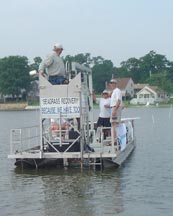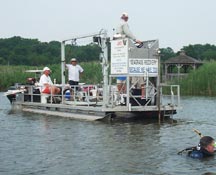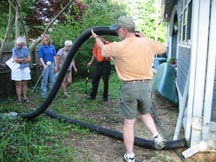
|
Dock of the Bay Digging Eastport The yard seems much smaller and the jungle gym is long gone, but Michael Matthews can still see it as it was 30 years ago. “I remember falling off of the merry-go-round,” says Matthews as she surveys the Chesapeake Avenue back yard. Today, instead of toys, her old nursery school playground is littered with archaeological excavation units.
“Excavating in Eastport allows us to consider a whole stratum of Annapolis society,” says Matthew Palus, the archaeologist running the day-to-day operations for the Eastport excavation. “Ordinary working people lived downtown too, but Eastportoricans treasure that heritage and the contrast between their community and the historic district.” Some of the preliminary discoveries reinforce Eastport’s identity as a working-class neighborhood. At one of the sites, the deed shows that several German immigrant families owned the home in succession. The 1910 census notes that the Braun family owned an Eastport slaughterhouse and sausage-making factory located only a stone’s throw away from downtown Annapolis. The census also shows that the Brauns hosted German boarders who worked in the factory. Palus’ next task is to use these historic documents and the site’s “material culture” — findings such as the machine-cut meat bones and a partially excavated foundation wall full of burnt charcoal — to tell a story about the property and its residents over the last century. This story will be written once the summer is over and the excavation is complete, when Palus heads to the lab to analyze and interpret his findings. Was the factory-produced meat part of the take-home pay for the German boarders living on the property? Is this wall all that remains of a smokehouse used for curing meats? These are the types of questions he will have to answer. Half a century later, from 1961-’64, the same property was the home of Aris T. Allen, a race-barrier-breaking physician, delegate and state senator. Race is another theme illuminated by the summer’s backyard digs. “We also believe that relations between African Americans and whites were different in Eastport. A special kind of African-American community grew up here, and archaeology is helping us to understand what made it different,” says Palus. “Aris T. Allen saved my son’s life on a house call,” one-time Eastport resident Lucinda Seebrat says. When the regular family doctor was unwilling to interrupt his golf game, the family’s housekeeper suggested Allen, who quickly diagnosed Seebrat’s son as diabetic and rushed him to the hospital. “Dr. Allen was widely respected by black and white folks,” says Seebrat’s daughter Jennifer Miller, who also took the tour of the site. Matthews, also one of Allen’s patients, remembers “waiting forever in his office. When you’re the only black doctor, every black family lines up.” After the Allens moved on, an African American daycare moved in. Vestiges of the nursery are plentiful, with one month of digging turning up an assortment of action heroes, clay and glass marbles plus easily discerned foundations and postholes for playground equipment. “We didn’t pick up our toys,” jokes Matthews.
“We sensed an opportunity in Eastport,” says University of Maryland professor Mark Leone, the program’s director, who likes nothing better than for people to come visit his excavations. It’s a misconception, Leone explains, that “if you let the community design research questions, then it’s not scientific.” Today’s students lead yesterday’s residents on tours of the archaeological sites. “I was nervous at the beginning, but it became very fun,” says Milagros Ruiz, a University of Maryland student working on this summer’s program. The last week of June was particularly busy for Ruiz and her classmates. Camera crews interviewed the students, who appeared on two local news programs and offered tours to the visitors, who alternated between the archaeology and music of the Eastport-A-Rockin’ festival. Other visitors included a steady stream of curious neighbors and 62 archaeologists from the Fifth World Archaeological Congress in Washington, D.C. The excavation project is not over yet, but the summer field school has ended, and most of the archaeology students have gone home. A handful of students remain to assist Palus as he wraps up the excavation. The lunch line at the local café is slightly shorter and Arthur’s dog has the former dig to herself. “My dog,” says Arthur, “was going a little stir crazy indoors. She likes full access to the yard.” But the work is only beginning for Palus, who is also writing his Ph.D. dissertation about the summer’s fieldwork. Using the historic documents, interviews with residents and the ceramics, bones, medicine bottles and utility pipes unearthed during fieldwork, he will assemble a story about working-class Eastport. He’ll focus on race and class as he seeks to answer questions: Who had access to public utilities such as water, electricity and sewage? Who had access to the formal banking and medical system? Does the material culture show that homeowners had a better diet and more valuable commodities than renters? How was the experience of Easport’s African Americans different from that of whites? For those answers, we’ll have to read Palus’ findings next year. — Sam Gordenstein Growing with the Bay Along the mouth of Back and Middle rivers in Rocky Point County Park in Baltimore, divers in full gear dot the shore, while several small motor boats use their radios to cover the movement of a one-of-a-kind boat, designed specifically for the mission it’s on here and now. It’s not a spy movie, though: This is an operation to save Chesapeake Bay.
“What we’re doing,” Rachel says, “is we’re taking Bay grasses and putting them into these seed pods. After we put them in, we put rubber bands on them, and the people out there transfer them into the water and bury them.” They’re doing this, Matthew says, “To save the Bay.” His big sister explains why. “The grasses, they provide protection for the blue crabs and other animals and also help filter the water. So that means they clean the Bay out and provide a place for the crabs to live.” You can tell by the way she talks that Rachel’s no rookie Bay crusader. “I know about Bay grasses because I grew them in my basement,” she says. It wasn’t an easy project. She had to clean the water the grasses grew in to rid it of oil and algae. Worse yet, there were a few power outages while she was growing them. “The grasses needed to be under light and kept warm, so that was hard. But afterward, I got to plant them in the water and that was fun,” she says. Typically, volunteers like Rachel and professionals from organizations like the Chesapeake Bay Foundation — which is running the planting at Rocky Point — have had to plant by hand, which is difficult and slow. Today, at Rocky Point, a new way of planting is under trial. The one-of-a-kind boat in the water is Jim Anderson’s J.E.B., short for Jim’s Environmental Boat. Anderson, a sod farmer from Florida, designed the planting boat with a pair of wheels, parallel to the boat and each other, that can be lowered through the bottom of the boat into the water. The spokes of the wheels are shaped like bottomless vases, and the wild celery seedlings prepared by Rachel, Matthew and other volunteers are loaded into these vases and drilled into muddy bottoms. So the boat is not a machine for subterfuge, and the divers are not secret agents. The link between them is competition, and the question is this:
As Rachel knows, these grasses are very important to the Bay, but about 90 percent of the Bay’s grasses have been killed by pollution. The quality of the water and the lives of blue crabs, fish and waterfowl are at stake. This means the fishing and crabbing industry, as well as restaurants and seafood enthusiasts, are all wrapped up in the fate of the Bay, and, thus, the fate of wild celery, eelgrass, redhead grass and other underwater grasses. Today, it’s wild celery, and gazing off one of the small motorboats overseeing the planting, it’s easy to understand that the health of the Bay affects anyone who has looked off into the spread of sun-struck water and felt at ease. “I’m having fun!” Rachel says earnestly. She and Matthew were up at 7am to make it from Owings Mills to Essex by 8:30. They won’t be leaving until 3:30. It’s a long day, but Matthew is pleased with the snail they found, along with a couple of blood worms. Both of them, like other volunteers — and like Jim Anderson’s Seagrass Recovery company, the Chesapeake Bay Foundation, federal biologists and scientists and even an aquatic nursery that is helping out — understand that their work is necessary. “Our Bay right now is really in trouble,” Rachel says. This week, the Bay’s plight has drawn a mix of children, adults, non-profit organizations and for-profit organizations all working together. A team like that fulltime could do wonders for our waters. — Jessie McLean Heller Mosquito Touring Usually, the mosquito looks for you. In North Beach last week, citizens went looking for mosquitoes. Guiding the tourists to potential breeding sites of Maryland’s worst mosquito pest, the Asian tiger mosquito, were Calvert County Mosquito Control officers Kristen Scott and Sonja Gatton.
They illustrated the tiger’s integration into community life with stories from the field to make their points. One Calvert homeowner stored an abandoned truck liner behind her home. “It filled with water, and the tiger mosquitoes discovered it,” said Scott. “They were using it to breed by the thousands.” Then they hammered their lesson home. “This yard has a basketball hoop,” noted Gatton. “The base that holds the pole up is filled with water to give it weight. If the plug is missing from the top of the base, it makes a perfect mosquito breeding container, too. The final stop was the back yard of councilman and driver Pendleton, who had filled his birdbath and put out props to show where mosquitoes breed. One was a 10-foot section of black, plastic, corrugated pipe. “In previous years I used it all the time to divert rainwater from the foundation,” Pendleton admitted. Now he’s seen the light. “I only put it out when I know it is going to rain,” he said, lifting one end high to show why. Out rushed a few gallons of stagnant water. “Perfect mosquito breeding habitat,” Gatton pronounced. “If people understand the problem, they can do something, but it requires community cooperation,” said Pendleton, who arranged the tour. To schedule a mosquito tour in your community:
— Bay Weekly In Annapolis, crabbers are rooting for legislation proposed in the Anne Arundel County council by County Executive Janet Owens that allows watermen to legally sell crabs and store equipment at their homes. The zoning change is needed to protect against the complaints of people who worry about diminished property values in communities where watermen ply their trade… In Washington, data from bald eagle surveys are in and the results are encouraging. Sightings increased by two percent in the annual U.S. Geological Survey and by 6.1 percent in the northeast. Scientists say America’s symbol has rebounded since the ban on the pesticide DDT. Read more at http://srfs.wr.usgs.gov/midwinte.htm… Our Creature Feature comes from Los Angeles where a life-and-death debate has erupted over the fate of a colony of feral Chihuahuas. Trouble began when 174 of them were seized from a woman’s home. L.A. animal control experts say the tiny dogs are too dangerous for adoption and likened them to a pack of tiny, hungry wolves. “They have a severe behavior problem,” an animal control spokeswoman said. |
© COPYRIGHT 2003 by New Bay Enterprises, Inc. All rights reserved.
Last updated July 24, 2003 @ 11:35am





